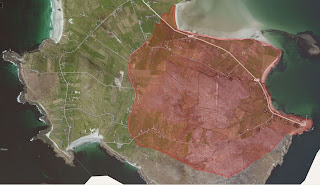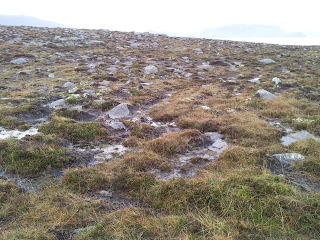Since the
start of my birding days in the early 70’s I seemed to have had a fascination
about how many species I could see wherever I happen to be. Testimony to that
being a flick through my notebooks where I’ve written out bird lists whether it
is an annual list for a ‘patch’ or the ‘holiday list’. Today it’s just the same
although I just write ‘notes’ in the notebook now and generate the ‘lists’ on
the computer!
So when the
‘patchwork’ challenge was mooted to me I was intrigued. However, I quickly
realised that it would mean a change to what I had become accustomed to calling
the ‘patch’. When I moved to ‘the Mullet’, over 10 years ago now, the term
‘patch’ represented the long thin strip of land, bordered by sea on either
side, that stretches from the bridge at Belmullet to Blacksod Point and within
this my patch list stands at 262. Now having read the rules, if I was going to
participate, I would have to nominate a ‘patch’ that is ‘a maximum area of 3 km2’.
I was up for it! So, and with little thought, I decided that I would just
‘stick-the-pin’ in the map, centred on the garden and draw a 1.5km radius
around! With a little re-gigging I was then left with a ‘patch’ that consists
mainly of rock-strewn Tarmon Hill …. Oh dear, maybe I should have gone ‘long
& thin’ with the aim of taking in more habitat? Well I’ve not and now
having spent a little time exploring the new ‘patch’ in the field I’ve
discovered a few areas that, in the past, I’ve paid little attention to;
hopefully they will deliver some #patchgold in 2013!
 |
| The patch |
So what
have I got to work with? Well the area that I know well is my own garden which
is situated on the ‘sheltered’ eastern slope of the hill. Fortunately the
garden and immediate area consists of mature trees and fuchsia ‘hedges’ which
are the first such gardens after leaving the Belmullet area some 12km to the
north (in between there is a lot of grassland!); the garden therefore attracts
migrants. It also overlooks Blacksod Bay and, to date, I’ve managed to notch up
151 species from within this immediate area. Some of the highlights being ‘from
the north’ Arctic Redpoll, ‘from the south’ Bee-eater, Red-rumped Swallow, Melodious
Warbler and Subalpine Warbler, ‘from the west’ Cedar Waxwing, Red-eyed Vireo
and Blackpoll Warbler, and ‘from the east’ Blyth's Reed Warbler, Yellow-browed
Warbler, Red-breasted Flycatcher and Rose-coloured Starling.
 |
| Top of the garden |
Leaving the
environs of my own garden and working along the ‘main’ road there are several
‘mature’ gardens clustered around Blacksod Point, and again are attractive to a
similar array of migrants which, with increased coverage in 2013 will hopefully
pull in some good patch birds! The pier at Blacksod also offers good views over
Blacksod Bay to pick up the likes of divers, mergansers, potential seaduck and
various gulls whilst along the shore are Brent Geese and a variety of waders,
although with little exposed mud it’ll be difficult to score American ‘peeps’!
Adding seabirds to the list may also prove difficult, particularly the petrels,
shearwaters and skuas given that the wild Atlantic is 6km away, but it’ll be
fun trying! I’m sure they’ll be a few storms to drive some seabirds into the
bay.
 |
| Blacksod gardens |
Freshwater
diving and dabbling ducks will also prove difficult to score given that there
is no ‘body’ of freshwater on the patch bar a small ‘puddle’ – this I call the duck
pond and has (remarkably!) attracted a Ring-necked Duck in the past; although
it didn’t stay long! For boosting the duck tally I’m going to have to
concentrate on scoping from the patch boundaries!
 |
| The duck pond |
The
majority of the patch is taken up by the granite intrusion known as Tarmon
Hill. This is basically a rock-strewn area interspersed with minimal vegetation
and exposed to all the elements which on the ‘face-of-it’ appears pretty
birdless. Okay its species range is pretty limited but it does appear
attractive to Snowy Owl given the number of records over the years, and so
worth a few points if I manage to connect!
 |
| Snowy was 'ere |
 |
| Tarmon Hill |
But
searching over the hill there are a few hidden habitats, in particular a central
marsh area, a few small pools, extensive long stone walls and a small failed
forestry plantation. With only cursory glances in the past I have seen Dotterel,
American Golden Plover, Pectoral, Wood and Green Sandpipers which are species I
haven’t seen anywhere else on the patch so with more coverage it could prove
useful in boosting the species list!
This new patch
doesn’t have an ‘official’ list but a tally-up from memory for 2012 generates a
list of about 129 species with several obvious gaps, but did include some
find-highlights such as Snowy Owl, Red-rumped Swallow, Blackpoll Warbler and
Cedar Waxwing! I’ve set myself a target of 150 species for 2013 – we’ll see –
but one thing for sure, it’ll be fun trying!
Oh my what a place to live! Patch of the day? Patch of the competition I reckon. I might have a flutter...
ReplyDeleteDo I detect a hint of #PatchEnvy here? Seriously though, what a stunning place!
DeleteIt looks fantastic; there's been some great birds there (although I assume the 1.5 km2 radius was a typo as it'd give about 7 km2 area [maybe I misread something]).
ReplyDeleteMark, I think Dave started by drawing a 1.5km radius and then trimmed it significantly to best bits of his patch. Got to agree with you, it looks an amazing patch!
DeleteSounds like a good way of doing it! It's interesting to read about what turns up on the west coast.
Delete